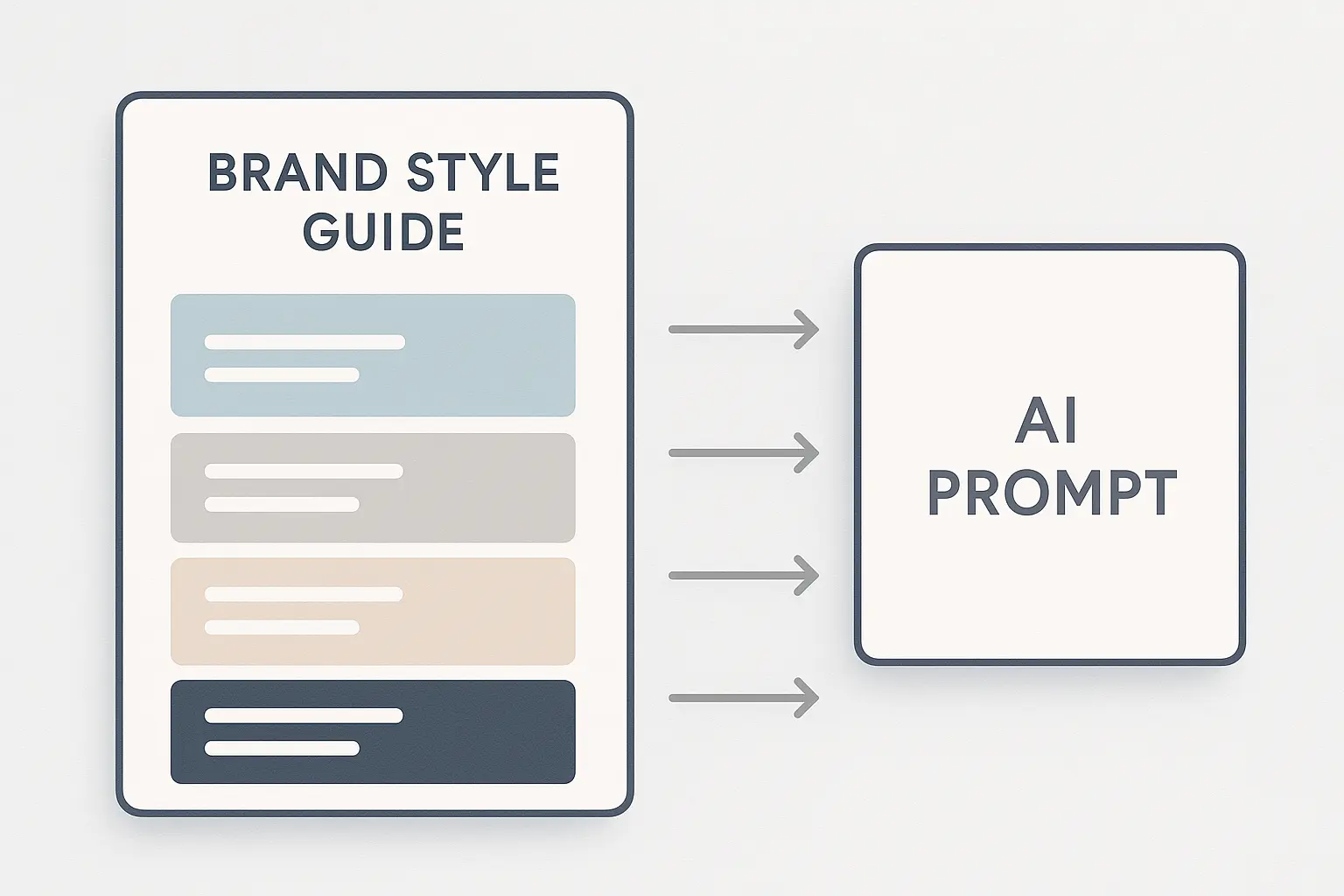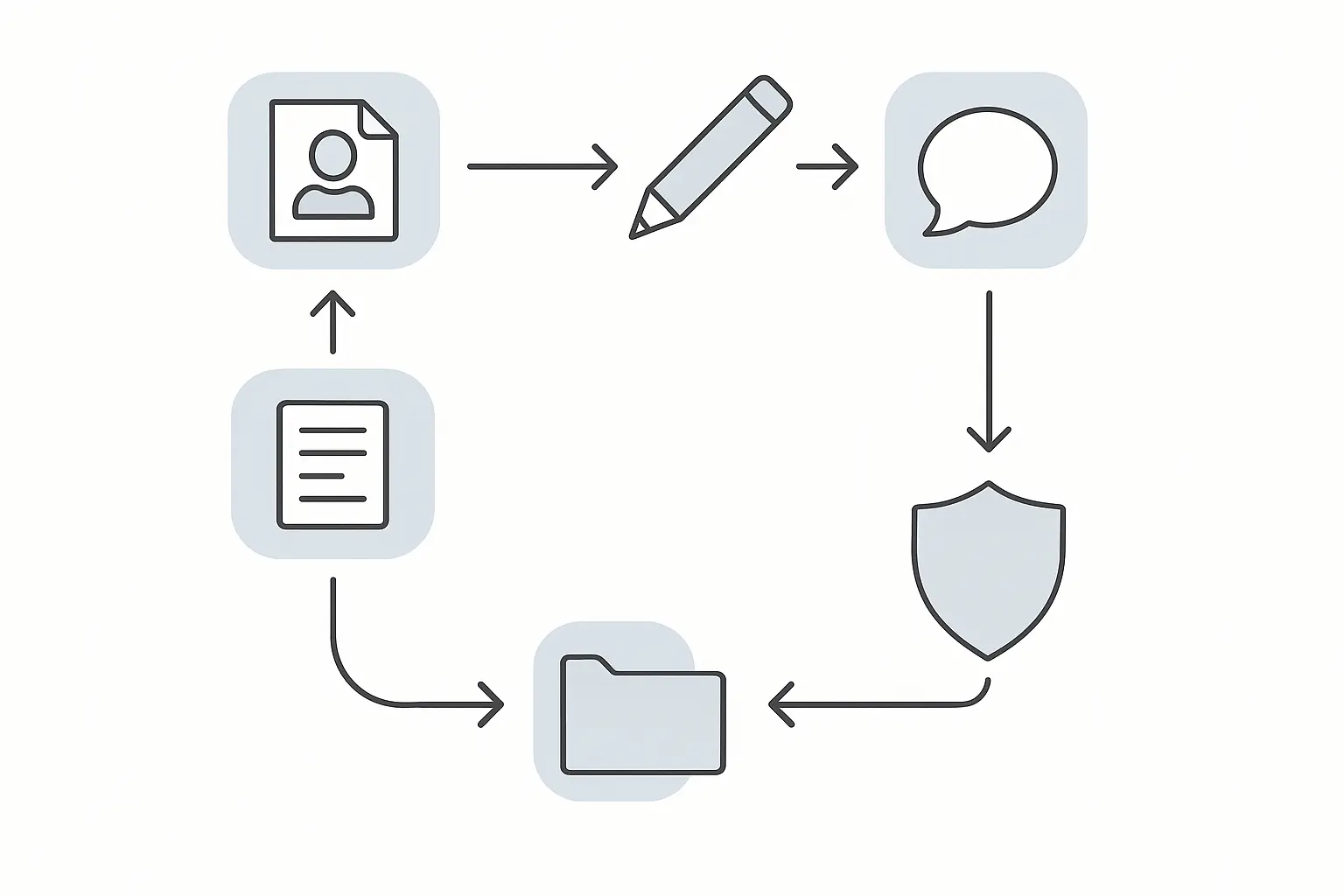You’ve been there. You ask your AI content tool for a blog post, and it delivers something that’s… fine. It’s grammatically correct and hits the keywords, but it has all the personality of a user manual.
When you paste it into your client’s CMS, it sticks out like a sore thumb—a generic, robotic imposter next to their carefully crafted brand messaging.
This gets right to the heart of the central challenge of scaling content with AI: maintaining brand consistency. For an agency juggling five, ten, or even fifty clients, each with a distinct voice, this isn’t just a frustration; it’s a critical roadblock. A staggering 90% of consumers expect a consistent experience across all platforms, and a generic AI voice shatters that expectation instantly.
The good news? The problem isn’t the AI. It’s the process.
You wouldn’t hand a junior writer a one-sentence brief and expect them to perfectly capture a client’s nuanced tone. So why are we doing it with our most powerful content tools?
The solution is to stop prompting and start training. This guide lays out a repeatable system for teaching AI to write in your client’s specific brand voice, turning it from a generic content generator into a scalable, brand-aligned creative partner.
Why Generic AI Prompts Are Failing Your Clients
In the race to produce content faster, it’s easy to fall into the trap of simple, task-based prompts like, “Write a blog post about the benefits of X in a friendly tone.” But that approach completely misses what makes a brand connect with its audience.
Think about it: 64% of consumers want brands to connect with them on an emotional level. Generic content doesn’t build connection; it builds content archives. It lacks the specific vocabulary, cadence, and perspective that makes a brand memorable and trustworthy.
And this isn’t just about feel-good marketing; the financial stakes are high. Research shows that consistent brand presentation can increase revenue by up to 23%. When every piece of AI-generated content sounds slightly different, you’re not just creating a disjointed user experience—you’re actively eroding the brand consistency that drives growth. It’s a common struggle, as only 23% of marketers feel their content strategy is very effective.
The “aha moment” for many agencies is realizing that AI should be treated like a new team member. It needs to be onboarded, given clear guidelines, and provided with examples of what “good” looks like.
Step 1: Deconstruct the Voice with a “Brand Voice Bible”
Before you can teach an AI a brand voice, you need to codify it. You can’t just say a voice is “professional yet approachable.” You need to break it down into concrete elements a machine can understand. That’s where a “Brand Voice Bible” comes in—a centralized document defining every aspect of a client’s communication style.
The Core Components of a Brand Voice
Every strong brand voice is a combination of four key elements. Your first task is to analyze your client’s best-performing content (the pieces that sound the most them) and identify the patterns.
- Tone & Attitude: This is the emotional color of the writing. Is it authoritative, witty, empathetic, inspiring, or urgent? Most brands have a primary tone and one or two secondary tones. Define them with a “This, Not That” framework.
Example: “Our tone is confident, not arrogant. We are helpful, not salesy.”
- Vocabulary & Lexicon: The specific words the brand uses—and avoids.
Words to Use: Industry-specific terms, branded features, positive-framing words (e.g., “opportunity” instead of “challenge”).
Words to Avoid: Competitor names, outdated jargon, corporate buzzwords, words that contradict the brand’s values (e.g., a “simple” software company avoiding words like “complex” or “complicated”).
- Rhythm & Sentence Structure: How does the writing flow?
Does it use short, punchy sentences or longer, more descriptive ones?Is it heavy on questions to engage the reader?Does it use active or passive voice?
- Formatting & Style: This covers rules for things like:
Use of capitalization (e.g., title case vs. sentence case for headlines).Use of bullet points, numbered lists, and bolding.Rules for citing sources or linking to other content.
Your goal is to create a comprehensive style guide that leaves no room for ambiguity. This document is the foundation for everything that follows. It’s essential for scaling content, whether you handle it internally or rely on white-label SEO services.

Step 2: Craft a Master Prompt from Your Bible
With your Brand Voice Bible complete, you can now translate it into a master prompt. This isn’t a simple, one-line request; it’s a detailed creative brief designed to give the AI all the context it needs to succeed. A great master prompt has four key parts.
The Anatomy of a Master Prompt
- Role & Goal: Tell the AI who it is and what it’s trying to accomplish.
Example: “You are an expert copywriter and brand strategist for ‘Client A,’ a B2B SaaS company that helps small businesses simplify their accounting. Your goal is to write a blog post that helps founders feel empowered, not overwhelmed, by their finances.”
- Audience Context: Describe the target reader and their mindset.
Example: “Your audience is non-technical small business owners who are often intimidated by financial software. They value clarity, simplicity, and practical advice they can implement immediately. Avoid complex jargon.”
- Style Guide Integration: Here, you’ll directly embed the rules from your Brand Voice Bible.
Example: “You must adhere strictly to the following brand voice guidelines:Tone: Confident and empowering, but not arrogant. Use a ‘we’re in this together’ attitude.Vocabulary: Use ‘team members’ instead of ’employees.’ Never use words like ‘synergy,’ ‘leverage,’ or ‘utilize.’Structure: Keep sentences under 20 words. Use bullet points to break up complex ideas.”
- Exemplar: Provide a short, “gold-standard” example of the client’s writing for the AI to mimic.
Example: “Match the style of this paragraph: ‘Running a business is tough enough. Your finances shouldn’t be. We built our platform to give you the clarity you need in just a few clicks, so you can get back to doing what you love.'”
This approach turns prompting from a guessing game into a predictable system. You can build these prompts manually or accelerate the process with AI-powered SEO automation platforms that help manage and deploy brand guidelines at scale.

Step 3: Review, Refine, and Repeat the Process
The first draft from your master prompt will be leagues better than a generic one, but the work isn’t done. The final step is creating a human feedback loop to continually refine the AI’s output.
Remember, 47% of B2B buyers consume 3-5 pieces of content before engaging with a salesperson. That means you need a steady stream of high-quality, on-brand content. An iterative process is the only way to achieve this at scale.
-
Review the Output: A human editor (you or someone on your team) must review the first draft against the Brand Voice Bible. Did the AI follow every rule? Where did it deviate, even slightly?
-
Refine the Prompt: Use your feedback to strengthen the master prompt. If the AI’s tone was too formal, add a new instruction: “Correction: Write in an even more conversational style. Use contractions like ‘you’re’ and ‘it’s’ freely.”
-
Repeat and Improve: Each time you run the prompt and provide corrective feedback, you’re making the instructions more precise. Over time, the AI’s first drafts will require less and less editing, dramatically speeding up your workflow.
This feedback loop is crucial. You’re actively training the system, creating an asset that improves over time and consistently generates on-brand content for each client in your portfolio.

Frequently Asked Questions
How long does it take to create a Brand Voice Bible?
For a client with established brand guidelines, you can likely compile a solid bible in 2-3 hours. For a client without a clear voice, this process is an opportunity to provide strategic value by helping them define it. This could take a bit longer but solidifies your role as a true partner.
Can I use this process for different AI tools like ChatGPT, Claude, or Jasper?
Yes! This framework is platform-agnostic. The principles of providing clear context, rules, and examples work across all major large language models. The structure of your master prompt remains the same.
What if my client doesn’t have a clear brand voice to begin with?
This is a huge opportunity for your agency. Position the creation of a Brand Voice Bible as a foundational strategic exercise. Run a workshop with them, analyze their competitors, and interview their customers to help them define a voice that resonates with their target audience.
Isn’t this more work than just writing the content myself?
Initially, yes. But it’s an investment that pays off exponentially. Creating one Brand Voice Bible and one master prompt can save you hundreds of hours in writing and editing time over the long term, allowing you to scale content production without sacrificing quality.
How do I manage brand voices for dozens of clients without getting them mixed up?
Create a dedicated folder for each client containing their Brand Voice Bible and a text file with their master prompt. This keeps everything organized and prevents cross-contamination of brand styles. It becomes a simple copy-and-paste workflow.
Your Path to Scalable, On-Brand Content
Moving from simple prompts to a systematic training process is the key to unlocking the true potential of AI for your agency. By creating a Brand Voice Bible, crafting a master prompt, and embracing an iterative feedback loop, you can transform your AI tool into a reliable partner that produces high-quality, on-brand content at scale.
The result is that your team can shift its focus from tedious first drafts to high-value strategic work—like analyzing performance, refining content strategy, and strengthening client relationships.
Scaling this process across a full client roster is the next challenge. For agencies looking to expand their offerings without the overhead, an SEO outsourcing partner can be a game-changer, providing the expert execution needed to make modern, AI-driven content strategies a reality.

